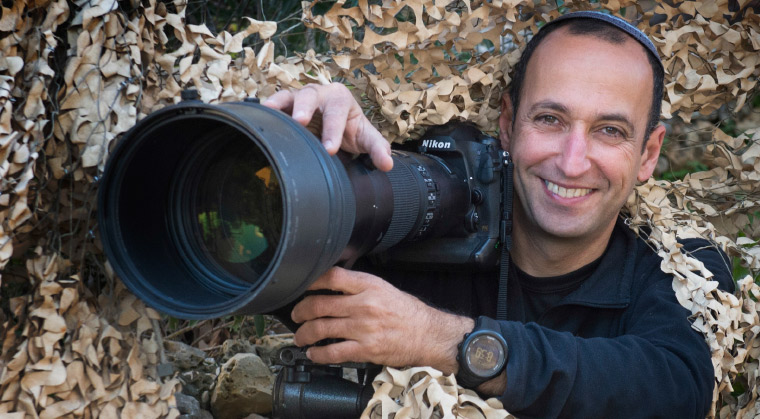Picture Perfect


(Photos: Shachar Cohen)
The first rays of the sun begin to appear in the east. The forest, dripping with early morning dew as pine and cypress trees sway gently in the wind, is still fiercely cold. The quiet is wondrous; not even the few birds that live in this forest in the southern Shomron flap their wings.
Shachar Cohen, dressed in warm clothing to protect him from the elements, makes his way quietly to the tent he has set up in the wee hours of the night. He has carefully designed the large tent so that it is indistinguishable from the surrounding scenery. Once inside, he sits … and waits. Without moving a muscle. Without disturbing the silence. Even when he hears the first chirping sounds of birds waking to a new morning, he remains perfectly still. He has to, if he is going to achieve his goal: capture a picture of the large bird of prey that has just risen from its nighttime slumber.
Predatory birds, Cohen later explains, are very sensitive to activity in their living space. One wrong move on his part, however slight, and the bird will fly far away, escaping from the forest that Cohen has invaded. In order to capture the coveted image, the 50-year-old Cohen has to be sensitive to the needs of the unofficial partners in his photographic enterprise.
When the sun finally rises, the bird appears in all its glory. Cohen positions his camera, and the large camera lens peeks out of the camouflage tent. Through the lens, Cohen sees the large bird drawing near. This is the critical moment. He has less than three seconds to decide if he should press the shutter, or wait for a better opportunity.
Cohen’s mind races at lightning speed. He decides the moment had come. The shutter clicks rapidly; he takes three pictures in a row to add to his chances of success. The bird, frightened by the sound, immediately changes direction and disappears into the distance.
Has he succeeded, or not? Drenched with sweat, Cohen rises from his crouching position and takes a deep breath before glancing down at the small screen. The first picture he rejects immediately; the bird’s image isn’t sufficiently clear. The second picture also isn’t particularly impressive. Just as he is about to admit defeat, the third picture appears on the screen.
Cohen smiles.
He has captured the bird from a phenomenal angle: legs bent, the bird is gazing off to its left as it soars into the sky. The picture is perfect.
“It can take hours, even days, before I’m able to capture the picture I want,” says Cohen. “But the satisfaction I feel when the picture is in my hands is well worth the effort.”
The Images of Israel
Shachar Cohen is considered one of the foremost photographers in the field of wildlife photography. His work is featured in many high-profile exhibitions in Israel, and he has won several prominent awards, both in Israel and internationally.
The photographs that he captures, of birds and mammals in their natural habitats, are the result of efforts that boggle the imagination — and are far beyond what is necessary for ordinary photographers. Every photo shoot requires intensive preparation, to learn about the creatures he intends to photograph and their environment. He must also figure out how to remain completely camouflaged, whether his work takes him to a windswept hilltop or deep within a thick forest. In many cases, the prep work alone, which requires a hefty dose of patience, can take weeks.
(Excerpted from Mishpacha, Issue 729)
Oops! We could not locate your form.













